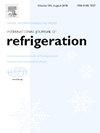Experimental study on dehumidification and heating performance of CO₂ heat pump system for electric vehicles at low ambient temperatures (5 °C and 15 °C)
IF 3.5
2区 工程技术
Q1 ENGINEERING, MECHANICAL
International Journal of Refrigeration-revue Internationale Du Froid
Pub Date : 2025-06-26
DOI:10.1016/j.ijrefrig.2025.06.029
引用次数: 0
Abstract
Efficient thermal management in electric vehicles (EVs) is critical for maintaining passenger comfort, particularly under cold and humid environmental conditions. Carbon dioxide (CO₂), as a natural, environmentally friendly, and thermodynamically efficient refrigerant, offers a promising alternative to conventional hydrofluorocarbon (HFC) refrigerants in vehicle heat pump systems. This study presents a dual-mode CO₂-based heat pump system specifically designed for EV applications, enabling flexible operation for both dehumidification and heating functions. Mode A utilizes an additional outdoor heat exchanger (ODHX) for refrigerant subcooling, enhancing dehumidification. Mode B eliminates ODHX, concentrating heat release in the gas cooler for superior heating output. A series of experimental investigations were conducted to assess system performance across a range of ambient temperatures and compressor speeds. Key performance metrics—including moisture extraction rate (MER), heating capacity, coefficient of performance (COP), and specific moisture extraction rate (SMER)—were evaluated under various operating conditions for both functional modes. The results reveal that at an ambient temperature of 5 °C, Mode B demonstrates superior heating performance, achieving 26.3–27.9 % higher heating capacity and a 26.3–27.6 % improvement in COP compared to Mode A, indicating its suitability for cold climate operation. Conversely, Mode A outperforms Mode B in mild-humid conditions (e.g., 15 °C), delivering 25.4–28.6 % higher MER and 26.3–29.2 % greater SMER, making it more effective for moisture control.
低环境温度(5℃和15℃)下电动汽车CO₂热泵系统除湿和制热性能实验研究
电动汽车的高效热管理对于保持乘客的舒适性至关重要,尤其是在寒冷和潮湿的环境条件下。二氧化碳(CO 2)作为一种天然的、环保的、热动力高效的制冷剂,在汽车热泵系统中为传统的氢氟碳(HFC)制冷剂提供了一个有前途的替代品。本研究提出了一种专为电动汽车应用设计的双模式CO₂基热泵系统,可灵活操作除湿和加热功能。A方式采用额外的室外热交换器ODHX进行制冷剂过冷,增强除湿效果。模式B消除了ODHX,将热量集中在气体冷却器中释放,以获得卓越的加热输出。研究人员进行了一系列的实验研究,以评估系统在环境温度和压缩机转速范围内的性能。关键性能指标-包括水分提取率(MER),热容量,性能系数(COP)和比水分提取率(SMER) -在两种功能模式的不同操作条件下进行了评估。结果表明,在环境温度为5°C时,模式B的供热性能优于模式a,其供热能力提高26.3 - 27.9%,COP提高26.3 - 27.6%,适合寒冷气候运行。相反,在温和潮湿的条件下(例如,15°C),模式A优于模式B,提供25.4 - 28.6%的高MER和26.3 - 29.2%的高SMER,使其更有效地控制水分。
本文章由计算机程序翻译,如有差异,请以英文原文为准。
求助全文
约1分钟内获得全文
求助全文
来源期刊
CiteScore
7.30
自引率
12.80%
发文量
363
审稿时长
3.7 months
期刊介绍:
The International Journal of Refrigeration is published for the International Institute of Refrigeration (IIR) by Elsevier. It is essential reading for all those wishing to keep abreast of research and industrial news in refrigeration, air conditioning and associated fields. This is particularly important in these times of rapid introduction of alternative refrigerants and the emergence of new technology. The journal has published special issues on alternative refrigerants and novel topics in the field of boiling, condensation, heat pumps, food refrigeration, carbon dioxide, ammonia, hydrocarbons, magnetic refrigeration at room temperature, sorptive cooling, phase change materials and slurries, ejector technology, compressors, and solar cooling.
As well as original research papers the International Journal of Refrigeration also includes review articles, papers presented at IIR conferences, short reports and letters describing preliminary results and experimental details, and letters to the Editor on recent areas of discussion and controversy. Other features include forthcoming events, conference reports and book reviews.
Papers are published in either English or French with the IIR news section in both languages.

 求助内容:
求助内容: 应助结果提醒方式:
应助结果提醒方式:


